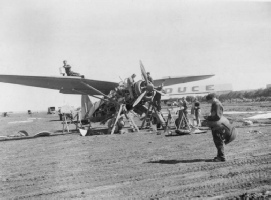The long awaited arrival of the first Hurricanes to replace the Lysanders began on 22 November when the pilots of ‘C‘ Flight left for Abu Sueir. They exchanged five Lysanders for Hurricane Is and spent the next two weeks at Amariya converting to the new type. A further Hurricane was being specially fitted out to carry cameras. This aircraft was to be used in areas considered too dangerous for the lumbering Lysander. The technique to be used was described in the squadron’s operations book as, “a quick dash is the order of the moment and for this purpose the Hurricane will be used exclusively”.
The Hurricane made its operational debut with the squadron on 4 December when Flt Lt Burnand carried out a Tac R south of Sidi Barrani. By this time the Italian advance had been halted and on the 9th, Operation Compass commenced when an Indian division launched an attack to recapture a camp. The squadron’s four Hurricanes supported this main attack and the Lysanders supported the 7th Armoured Division, which was protecting the southern flank. The attack made good progress and o n the 11th, Sidi Barrani fell, Buq Buq was occupied and the camps at Sofafi and Rabia were surrendered with all equipment. 38,000 prisoners were taken, and 237 guns and 73 tanks were captured. By the end of the following day, the Italians had only three toeholds in Egypt, Sollum, Fort Capuzzo and Sidi Omar. Despite having to contend with sand storms, the squadron had made a major contribution to the army’s success.
n the 11th, Sidi Barrani fell, Buq Buq was occupied and the camps at Sofafi and Rabia were surrendered with all equipment. 38,000 prisoners were taken, and 237 guns and 73 tanks were captured. By the end of the following day, the Italians had only three toeholds in Egypt, Sollum, Fort Capuzzo and Sidi Omar. Despite having to contend with sand storms, the squadron had made a major contribution to the army’s success.
General Wavell decided to capitalise on the successes and he started preparations for an attack on the port of Bardia. The Hurricane flight was kept busy over the next few days with regular sorties to monitor the Italian military situation in Bardia and Tobruk. Wilson was promoted to squadron leader on 16 December and assumed command of the squadron from Squadron Leader Sprague who had been promoted to wing commander. He had commanded the squadron over a period of intense activity and a few weeks after his departure it was announced that he had been awarded the DFC, the first award to the squadron in World War Two.
The end of December 1940 saw both the Hurricane and the Lysander flights heavily engaged in the Army’s advance and on the 31st, the squadron received orders to support the assault on Bardia. The following day, the attack was launched. During the six months of 1940, following Italy’s entry in to the war, the squadron had established a pattern of operations that would serve it well over the next four-and-a-half years.
Graham Pitchfork
Naval 8 - 208 Sqn Association Historian
This article first appeared in the 2020 Newsletter.








